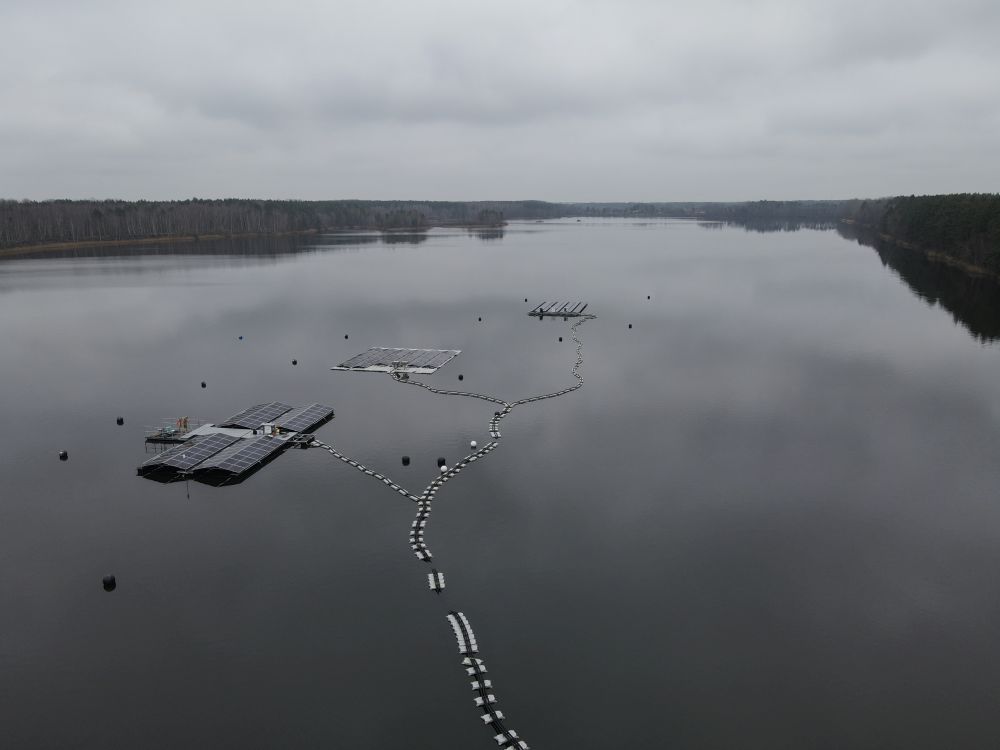| Duration: | 05/2021 - 12/2025 |
| Contracting Authority/ Sponsors: |
Federal Ministry of Economic Affairs and Climate Action (BMWK) |
| Project Partners: | Applicants: Brandenburgische Technische Universität Cottbus-Senftenberg (BTU) Associated: RWE Renewables GmbH |
| Project Focus: | |
| Website: | PV2Float |
PV2FLOAT
Technology development for floating PV power plants and their implementation for use on artificial waters
Floating photovoltaics (FPV) refers to PV power plants whose modules are mounted on floating bodies on a body of water. The concept enables the expansion of renewable energies on artificial lakes without occupying scarce land areas. Flooded former opencast lignite mines alone offer a technical potential of about 26 GWP of installed capacity, assuming an occupancy of 0.6 MW/ha.
In »PV2FLOAT«, an interdisciplinary team is investigating the opportunities and challenges of floating PV in order to create the technical, ecological and socio-economic conditions for tapping this potential. The project is dedicated to the further development of floating PV power plants with a view to cost reduction, integration into spatial planning and sustainable implementation on a megawatt scale. The economic viability and ecological impact as well as the potential and acceptance of the technology are analyzed with a focus on the conditions in Germany.
The development and installation of several FPV systems with different system designs and each with an output of approx. 30 kWp on an open-cast mining lake in Lusatia form the basis for holistic concepts in terms of practicality, economic viability, environmental compatibility and social acceptance.
Potential analysis and site selection for the test facility
Based on a market and site analysis, an assessment of the expansion potential for floating PV systems on Lusatian opencast lignite lakes is carried out and a site is selected. The potential analysis is based on information from geographic information systems.
Approval processes and acceptance
Efficient approval processes and early public relations accelerate the process in the run-up to project development. A process model for the approval procedure and a participation procedure are to be developed. Social, regulatory and organizational aspects (e.g. public perception, conflicts of use, e.g. in water sports, approval procedures and environmental protection) will be investigated.
Reliability, quality assurance and standardization
In order to increase the efficiency and lifetime of the technology, the system components for FPV systems are investigated for their reliability in the TestLabPV Modules at Fraunhofer ISE. The specific requirements and stresses (e.g. humidity, salt, bird droppings and fungal attack or mechanical stress) are evaluated and form the basis for the development of accelerated test programs and the testing of the individual system components. Furthermore, potential impacts of the system on water bodies are considered.
Module development
PV module materials are tested and characterized for their reliability on water bodies. Module assemblies are being developed that are particularly suitable for use on and near bodies of water. For this purpose, specific load factors are determined with regard to the long-term durability of the modules and encapsulation components, and test programs are defined. Subsequently, the anti-fouling behavior, the resistance of the modules and, in particular, suitable backsheet films are tested and optimized.
Design, construction and operation of the test facility
The test facility will be designed and erected at the selected site. Based on the system designs, different substructures and innovative anchorages will be compared. The installed power of the respective system design shall be 30 kWp. At the same time, a reference to an onshore installed reference system in the Outdoor Performance Lab at Fraunhofer ISE shall be established and a suitable measurement and monitoring concept shall be developed to compare the different FPV system designs with each other and with the PV ground-mounted system.
Optimization and scaling to large plants
Project results for floating PV are evaluated and optimized and scaled for large-scale systems. The long-term goal is to compete with MW-scale ground-mounted PV systems.
Revenue model, profitability and sustainability
In order to produce reliable yield forecasts, the available simulation programs will be adapted and validated with models and parameters of the floating PV experimental plant. A life cycle analysis will be performed and the energy payback time of the plant will be considered.
Ecology
Due to shading by FPV plants, less sunlight is available to the aquatic ecosystem. This not only affects the heat balance, but also primary production and thus material cycles and food webs. On the basis of limnophysical measured values, a model-based transferability of the ecological effects at different plant scalings will be made possible. Ecological criteria for the use of floating PV systems will be defined, and ecological requirements for construction and operation will be developed.
The test facility with different, comparative designs of the substructures will be used as a real laboratory for long-term analyses and demonstrations following the project.
